The Beginning of Naritasan
-
1
Towards Kanto with Kancho Daisojo and Fudo Myo-o
In 939 C.E, Taira no Masakado, a warlord in the Kanto area, claimed to be the new emperor. He opposed the Imperial Court which caused civil war to break out. During this turbulent time, people were forced to live in anxiety and confusion. Kancho Daisojo (who is in relation to the story) received a prayer order from Emperor Suzaku. It was to pray for the conflicts resolve. He departed for the capital city of Kyoto with the sculpture, "Fudo Myo-o” sculptured by Kobo Daishi Kukai, a historical high priest. Kancho headed for the Kanto area by sea and arrived at Odaregahama Beach on the Boso Peninsula.
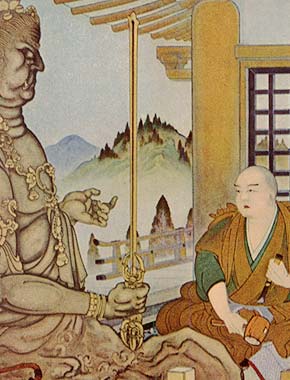

-
2
The conflict got settled down and Naritasan was opened with the name as Shinsho-ji
After arriving on land, Kancho proceeded on foot to Narita with "Fudo Myo-o" to pray for an end to the civil war.
After a 21-day Ogoma prayer, the rebellion ceased and peace came to the lands of Kanto.
As Kancho Daisojo attempted to head back to the capital, Fudo Myo-o became unmovable as a big stone. The statue then proclaimed "I will remain in this land and save its people".
The emperor officially named the temple, "Shinsho-ji" and so Naritasan Shinsho-ji Temple was established in the land of Narita.

-
3
Gathering the enormous faith of the people
Since the opening of the temple many historical figures have worshiped "Fudo Myo-o". Including Minamoto no Yoritomo (head of Kamakura Shogunate), Mito Mitsukuni (deputy general of Edo Shogunate), and Ninomiya Sontoku (who restored over 600 rural villages).
In the early Edo period Kabuki became popular among the common people. Actor Ichikawa Danjuro (first generation) was one of the performers who worshiped the Naritasan Fudo deity.
Danjuro, the most popular actor then, performed Fudo Myo-o's play under the name of Narita-ya, and thanks to that the religion of Fudo Myo-o quickly spread.
Narita-ya, the distinguished Kabuki family has passed down their belief to today. Whenever there was a succession of the family name, a visit to the "Fudo Myo-o" was made for worship. The depth of their faith can be seen by the offerings left on the temple grounds.
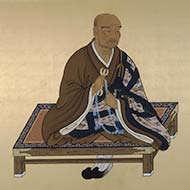
Kancho Daisojo
Kancho Daisojo is the grandson of Emperor Uta. Born in 916 C.E. as the second child of Prince Atsumi, he left his house at the age of 11. He served as the leader of Ninna-ji Temple, Todai-ji Temple, Sai-ji Temple, and was also the head of To-ji Temple. In 986 C.E., he became the third Buddhist priest of the Shingon sect in Japan. This following Gyoki Bosatsu and Jie Daishi Ryogen.
He is a renowned singer of the traditional music "Shomyo", which is the chanting of Buddist sutras. This is where you sing passages in sections. The specific style of "Tomitsu Shomyo" singing was originally created by Kancho Daisojo.
Fudo Deity
Naritasan's Fudo Deity
"Fudo Myo-o" is a deity that Kobo Daishi carved with humble prayer.
The "Fudo Myo-o " is the deity that Kobo Daishi humbly carved; making a respectful bow three times for each carving.
For over a millennium here at Naritasan, we have received blessings from "Fudo Myo-o". We also continually pray for the fulfillment of your wishes, as the fire from Ogoma has kept her flame shinning bright over the years.
In Ogoma, monk's prayers and yours are united, so that you can have benefit in the current life, as your wishes are delivered to the Fudo deity and fulfilled. Even now Naritasan's "Fudo Myo-o" gathers many worshipers from all over the country.
During your visit you can enter the Daihondo Hall and worship the Fudo deity.
-
Fudo Myo-o's Appearance
“The Fudo Myo-o" removes all kinds of worldly desires and saves all people”

He assumes the appearance of Dainichi Nyorai, the highest Buddha of Shingon Esoteric Buddhism.
His face looks enraged so that he can take away the worldly desires that lead to confusion in our hearts and save all of mankind. The importance of the spirit of service is shown by the dark blue color of his skin and his manly look. The sword in his right hand casts away hesitation and symbolizes “Buddhist enlightenment's wisdom”.
He uses the rope in his left hand, a Kensaku (snare rope), to tie up the wordly desires. This brings back people who have strayed from their path by giving them guidance. The large rock that the “Fudo Myo-o" is sitting on is called Daibanjaku. It represents his steadfast determination to endure all the hardships to save everyone. The big flame behind burns out the various obstacles that fall on us. -
Fudo Myo-o Goshingon (Mantra)
Words of prayer to the Fudo Myo-o
“Praying Always Results in a Miracle”
The buddhist word Goshingon is a specific mantra (chant), which was originally noted in the Sanskrit language.
As Kobo Daishi Kukai said “The mantra is something fascinating. If you sing it while thinking of the deity, the darkness of fundamental ignorance shall be removed. Many truths are hidden within only one word and through that you can receive Buddhist enlightenment in your current body. This means that many truths lie in these short mantras.
At Naritasan, we pray for the fulfillment of our heartfelt prayers by singing “Fudo Myo-o Goshingon” together with all of you during the Ogoma prayer. If you work hard and pray for success, the Fudo deity will always benefit you. Please sing these mantras every day and you will be rewarded with a miracle.
Naritasan and Kabuki

Ichikawa Danjuro and Naritasan's Fudo Myo-o
-
1. The first and the second, the origin of “Narita-ya.”

Ichikawa Danjuro was the first Kabuki actor to introduce Aragoto (combat plays). "Shibaraku" and "Narukami" are two well known plays of this combat style. He was a popular leading figure in Edo Kabuki, but he was not blessed with a successor. This lead him to pray to "Fudo Myo-o" for the birth of a son, which he was miraculously blessed.
In order to give thanks to "Fudo Myo-o", Danjuro the first and his treasured son who later became Danjuro the second costarred "Tsuwamono Kongen Saga" at Nakamuraza theatre. The content of the performance represents gratitude for "Fudo Myo-o" for blessed with the son after prayers were heard. It was very first Kabuki play featuring the theme of "Fudo Myo-o". The stage was a big hit and Danjuro made an offering of a large sacred mirror to Naritasan. Ever since the coacting, Ichikawa family started to use the name of Narita-ya as well.
At the same timing when Naritasan had an exhibition at Edo Fukagawa, moving deities outside of Naritasan for the first time, Danjuro the first and the treasured son, Danjuro the second costarred a Kabuki play "Naritasan Bunshin Fudo" (Fudo Child) and it was a smash hit. It was the moment that Ichikawa Danjuro's devotion toward Naritasan and the spirit of "Fudo Myo-o" were embodied, and the mystery was spread all over Edo.
The treasured son, Danjuro the second who was given birth after receiving the spirit of "Fudo Myo-o" was called as "Narita Fudo's heavenly child". He established himself as a child Kabuki actor at the age of 10. After his father passed away, he inherited the name Danjuro at age 17. He was praised for performing wonderfully, from the style of Aragoto (combat plays) to Sukeroku of Wagoto (soft-style plays).
Danjurro the second had dedication toward Fudoson belief as faithful as his father. The year Danjuro the second inherited the name, he had a fasting practice at Naritasan praying for improving his art of acting. And also when he suffered from illness, "Fudo Myo-o" healed him after hearing his prayer while giving him spiritual experiences. There are many stories of that kind.
-
2. The 7th & 8th Generation. “Sansho no Gakudo Hall”

Danjuro the 7th was an extremely successful and popular actor. He established the famous Kabuki Juhachiban (18 Grand Plays of Kabuki)and had many children. However, he had no luck in having a boy, so again he prayed to the Fudo deity for a successor.
That wish was granted instantly and his long awaited successor was born. They say he was so happy that he brought his newborn son the very next month to show him off on stage. This new successor, Danjuro the 8th, also inherited the name Danjuro at the age of 10 like his father. He was the last Danjuro in Edo and very popular because of his good looks.
The Tenpo Reforms(economic policies introduced in 1842 by the Tokugawa Shogunate) banned the luxurious life of Danjuro the 7th. He was then banished from Edo for eight years as punishment. His son, Danjuro the 8th, prayed to the Fudo deity with all his heart for his father's release. Upon this prayer, his father's exile ceased.
This father-son bond was praised by people in far-away regions and lead to an even bigger popularity of Danjuro the 8th.
Danjuro the 7th donated the large sum of 1000 Ryo(equivalent today 130million Yen) to build a Gakudo Hall in his gratitude to the Fudo deity.
When the Gaudo Hall was built, he hung a handwriten sign reading "Guest Room". Here he gave tea and sweets to the visiting travelers.This hall was named “Sansho no Gakudo Hall” after the family crest of the Ichikawa family.
Among all the many named Danjuro, the 7th in particular had the strongest faith in "Fudo Myo-o". He performed various dedications to show the scale of his gratitude towards the deity, besides just the Gakudo Hall.
-
3. The faith for Fudo seen in Kabuki

In Kabuki there is an art called "Mie". It is the stage effect performed when acting is about to reach climax, the actor freezes his expression and keeps the same pose for a while. It is "Fudo Myo-o" 's unchanging heart expressed in Kabuki. The "unmovable Mie" created and acted by Danjuro the second was the masterpiece.
The Fudo belief spread around Edo thanks to the popularity of Danjuro the 2nd . The rumor stated that if you are glared by the “Fudo No Mie”, various diseases you may have will be cured.
The “Fudo No Mie” is something permitted only to the Ichikawa family in the world of Kabuki. It is said that the Fudo's spirit resides within the Mie stance. Moreover, the "glare" (nirami) which is delivered by the Ichikawa family as well, shows the miraculous nature of the Fudo's power to cleanse.
It is proof of Danjuro's deep faith in the Fudo deity.Danjuro the 9th devised the Sanskrit scattered Mizugoromo clothes, which were treated with Sanskrit characters representing the Fudo, as the strong man's clothing in “Kanjincho”. The picture of the Kabuki stage during the Edo period depicts the Benkei and Fudo Myo-o, who are wearing Mizugoromo clothes with Sanskrit characters embroidered with gold thread. Benkei, in the form of a mountain spirit, has long been believed to be the Fudo's appearance.
Many Kabuki plays originate from the Ichikawa family's faith in the Fudo religion.
Annual Events




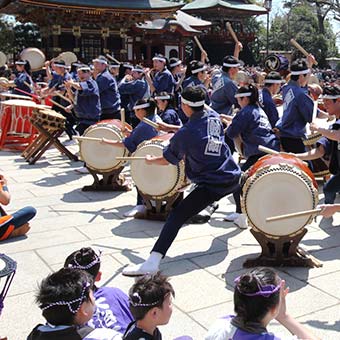
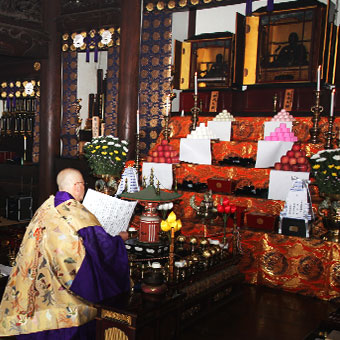





| JANUARY | A Vibrant Month at the Beginning of a New Year |
|---|---|
| Jan 1 | Gancho Ogoma-ku |
| Jan 7 |
Nanakusa Goinmon
A traditional event where you can receive the seal of the "Fudo Myo-o" on your forehead. During this event you pray for good health, academic success, and protection against illness. This is done by stamping a red seal on the forehead, which is engraved with Sanskrit characters that represent "Fudo Myo-o" in appearance. |
| Jan 8 |
Daihannya-e
Wishes for five grains (rice, wheat, millet, beans, and foxtail millet; the necessary grains of life) by reading of Daihannyakyo Sutra. This is the recitation of 600 volumes of the Sutras, which are read aloud to the surrounding visitors. When you read scripture from the Sutras, it is said that you may gain protection from illnesses. |
| Jan 28 | First Fudo |

| FEBRUARY | A month filled with prayers for passing exams and fulfillment of your wishes in the premises of the temple. |
|---|---|
| Feb 3 |
Setsubun (Bean-Throwing) Festival
Sumo wrestlers and TV actors throw beans into the audience. Sumo wrestlers and performers from NHK Taiga drama (large scale historical drama)throw beans to pray for peace in the land, welfare of the people, a good harvest, and the turning of disasters in fortunes. |
| Feb 3-9 |
Hoshikukito-e (Star Offering Prayer Festival)
A festival of nine stars that are responsible for the good luck of people It is a traditional ceremony that prays for one year full of happiness and no disasters. Every year we worship for one week, beginning on Setsubun. At the Komyodo Hall, you can obtain a "star offering amulet" which prays for good luck and the eradication of disasters. |
| Mid-February to Mid-March |
Narita Plum Festival
The blooming red and white plums at Naritasan park. Enjoy the sights of over 460 red and white plums. On Sundays and national holidays you can find rare events such as: concerts, ice sculpture exhibits, and photo contests. |
| Middle of the month |
“Shusse Inari Sairei Otaiya” & “Shusse Inari Festival”
Pray for fire safety, good luck, and business prosperity Every year in February, on the day of "Ni no uma", a big gathering of Buddhist service is held. And the day before they conduct "Otaiya Houraku"; a special ritual. Other rituals of singing and dancing for the deity are held as well. Free amazake (warm sweet sake) is served also. |

| MARCH | A Month Filled with the Scent of Plum Tree Flowers |
|---|---|
| Mid-February to Mid-March | Narita Plum Festival |
| Mar 5-7 |
Jikkaza Jumanben
Singing the Fudo Goshingon (mantra) 100,000 times in 10-round Ogoma Prayer In front of the Gomadan (fire pit in front of "Fudo Myo-o"), a special amulet called the "700 Shido Fuda" will be used to pray for the peace of the congregation. This is done whilst striking a big Mokugyo (fish-shaped wooden drum) and reciting the Goshingon. |
| Spring equinox day | Higan-e |

| APRIL | A month of encounter with full bloom beautiful cherry blossms |
|---|---|
| Apr 1-8 |
Hanamido Kanbutsu
Celebrate the birth of Buddha who founded Buddhism Pour sweet tea into the Buddha and celebrate the birth of Buddha at the flower alter in front of Shakado Hall. |
| Beginning of the month |
Naritasan National Calligraphy Competition Award Ceremony
Award ceremony honoring youth The award ceremony is held for those who have received special prizes at the Naritasan National Calligraphy Competition. Prior to the award ceremony, |
| Beginning of the month | Flower Festival Parade |
| Apr 8 | Buddha's Birthday Celebration |
| Middle of the month |
Narita Drum Festival
Drum formations from all over the country take part and perform in this festival. Highlights are the “Sengan Hana Daiko”, where about 800 performers play their drums in a prayer for peace. Also "Naritasan Millennium Night Stage", which plays on a stage lit by a bonfire in the evening. A parade takes place as well on the main street with many performers. |
| Apr 28 |
Tea Whisk Memorial Service
Buddhist rites for used tea whisks Old tea whisks used for serving matcha are given to commemorate after finished their work. Tea whisks are burnt with thanks and prayer for the development of the tea ceremony culture at Tea Whisk Mound in front of calligraphy museum in Naritasan Park. |
| End of the month | Commemoration in Gratitude of Shotoku Taishi |

| MAY | A Month of Carp Banners Dancing in the Clear Sky |
|---|---|
| May 8 | Daihannya-e |
| Middle of the month |
“Heiwadaito (Peace Tower) Festival” & “Offering Dances”
Prayer for eternal peace on earth. Believers, who gave "Fudo Myo-o" statues and hanging Buddha offerings, gather at the Peace Tower. Here they make a prayer for eternal peace on earth. |
| May 27 |
Festival for Gratitude Towards the Appearance of the Great One
Expressing gratitude at the land where the deity settled. In the Heian era, Kancho Daisojo carried the statue of "Fudo Myo-o" from the port of Namba to Kanto by sea. The land where he settled was Osaregahama which is part of Kujukuri Beach. A ceremony for expressing gratitude towards "Fudo Myo-o" has been practiced since the founding of the temple. It honors the holy land and gives thanks for his divine protection. |
| End of the month |
Good Luck Bonfire Ogoma, Firewood Burning Prayer, Fire Walk Training
Outdoor Ogoma prayer and fire walk After performing an outdoor Ogoma prayer, a fire ritual for good luck and prosperity is done when the fire goes out. This is carried out by the mountain monks and it prays for the fulfillment of the worshipers' wishes. |

| JUNE | A Month Where Hydrangeas Stand in Gentle Rain |
|---|---|
| Beginning of the month |
Sutra contest
Celebrating the birth of Kobo Daishi and Kogyo Daishi. In celebration of the birth of Kobo Daishi and Kogyo Daishi, a sutra contest is held to copy the “Hannya Shingyo”. The transcribed sutras ware dedicated to the Peace Tower and serve as prayer for fulfillment of the desires. |
| Beginning of the month |
Benzaiten Festival
Once a year event of opening doors to the deities. Once a year for two days, we open Benzai Tenson that presides over music, talent of speech, and good fortune for public and award Benzaiten Festival special amulet card. |
| June 15 |
Kobo Daishi's and Kogyo Daishi's Birthday Celebration
Special thanks to the founder and the restorator of the Shingon sect. June is the birth month of Kobo Daishi Kukai, who held the Shingon sect, and Kogyo Daishi Kakuban, who revived the teachings of Kukai. We carry out this memorial service to thank both Kobo Daishi Kukai and Kogyo Daishi Kakuban. |
| JULY | A vibrant month of summer in the sunlight |
|---|---|
| Beginning of the month |
Naritasan Gion Festival
An early summer tradition with a 300-year history We open Okunoin Hall, where Dainichi Nyorai is enshrined, only during this time. Here we pray for an easy life full of fortunes and the 'Five Grains Harvest'. A parade float travels around town with a mikoshi (portable Shinto shrine), which resembles Dainichi Nyorai. Also at Komyodo Hall, a special ceremony with a heavenly sword incantation is held. |
| July 12 | Temple Opening Anniversary |
| Middle of the month |
Dawn Lecture
Lectures following the rigorous morning Goma In the early morning of summer, we invite lecturers who are active in various fields to hold courses. |

| AUGUST | A month you feel nostalgia in the sounds of crickets |
|---|---|
| Aug 13-15 | Urabon-e (Feast of Lanterns) |
| Aug 16 | Segaki Daiho-e |
| Aug 23-24 | Mitama Festival Bon-Odori Dance Festival |
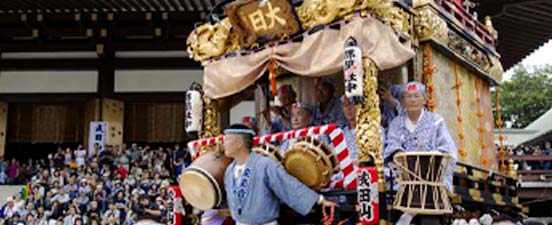
| SEPTEMBER | A Month Fruitful with Golden Rice Ears |
|---|---|
| Sept 8 | Daihannya-e |
| Sept 23 | Higan-e |
| End of the month | Good Luck & Bonfire Ogoma, Firewood Burning Prayer, Fire Walk Training |
| Sept 27 | Festival for Gratitude Towards the Appearance of the Great One |

| OCTOBER | A Month of Refreshing Autumn Breeze |
|---|---|
| October 1 to November 30 |
Shichi-Go-San Prayer
A Japanese traditional event to celebrate the growth of children. We celebrate and pray for children aged 3, 5, and 7. In addition to their good health, we also pray for academic success. |
| Middle of the month | Sutra Contest |
| End of the month | Gagaku Music Concert |
| Oct 20-21 | Narita Gen Festival |
| October 20 to November 15 |
Chrysanthemum Festival
Amazing chrysanthemums add color to the temple grounds. A wide variety of chrysanthemums will be displayed around Daihondo Hall, along with bonsai and pottery from the Naritasan Chrysanthemum Association. The best time to see the chrysanthemums is at the beginning of November. Another must see at this time is the cliff bonsai in front of Daihondo Hall. |
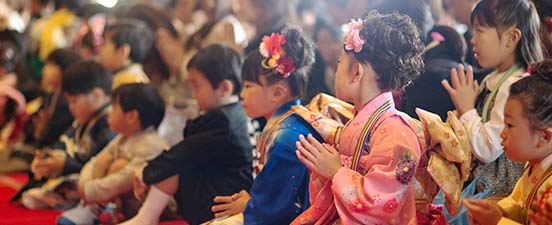
| NOVEMBER | A Beautiful Month with Colorful Leaves |
|---|---|
| October 1 to November 30 | Shichi-Go-San Prayer |
| October 20 to November 15 | Chrysanthemum Festival |
| Middle of the month | Autumn Leaves Festival |

| DECEMBER | A Month to Graciously Reflect on the Prior Year |
|---|---|
| Dec 8 |
Celebration of Buddha's Enlightenment
(After the memorial service, longevity porridge is served) |
| Dec 27 | Festival for Gratitude Towards the Appearance of the Great One |
| Dec 28 |
Votive Card Burning Lantern Ogama Prayer
Burning of the Ogoma cards that bestowed us with divine protection throughout the year It is an outdoor Ogoma prayer with gratitude for Ogoma amulets and protection charms by burning up. By returning amulets and charms to flame that represents Fudo deity, we give thanks to the year-round blessings. |
